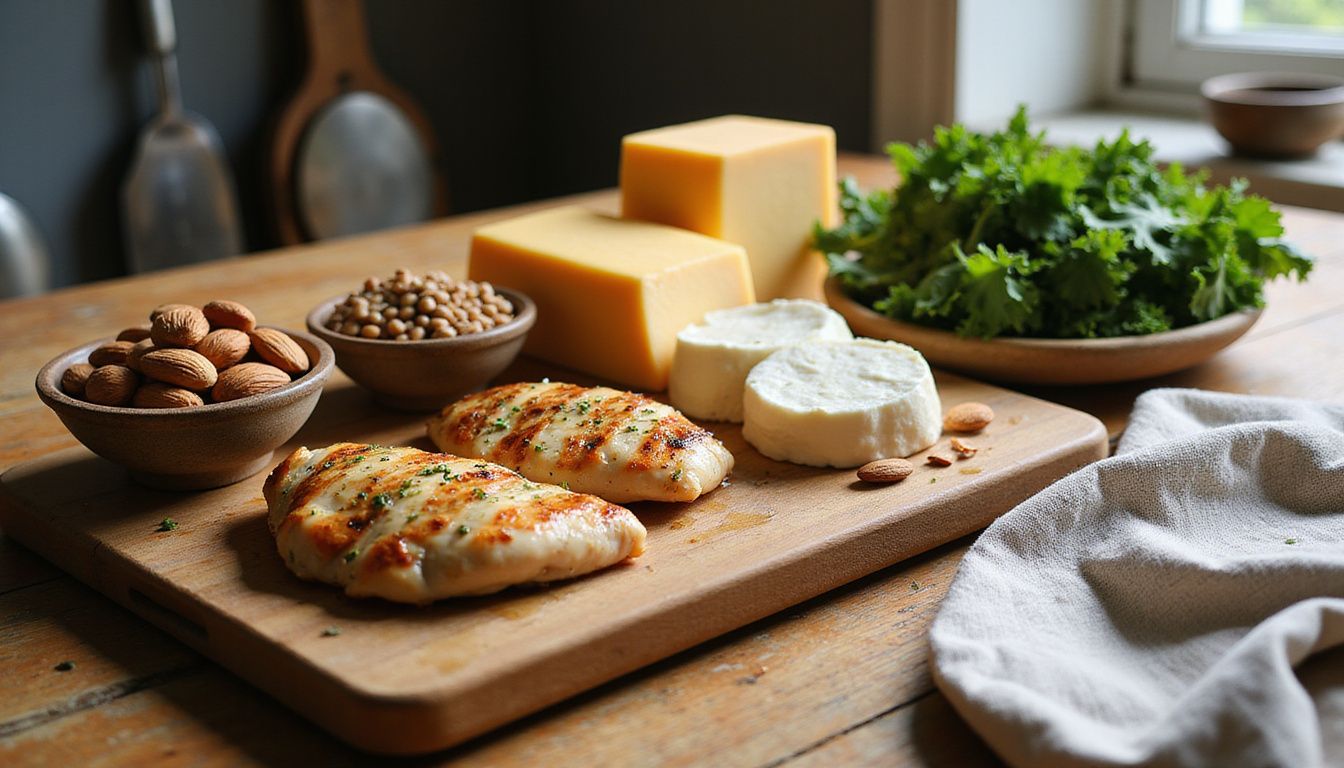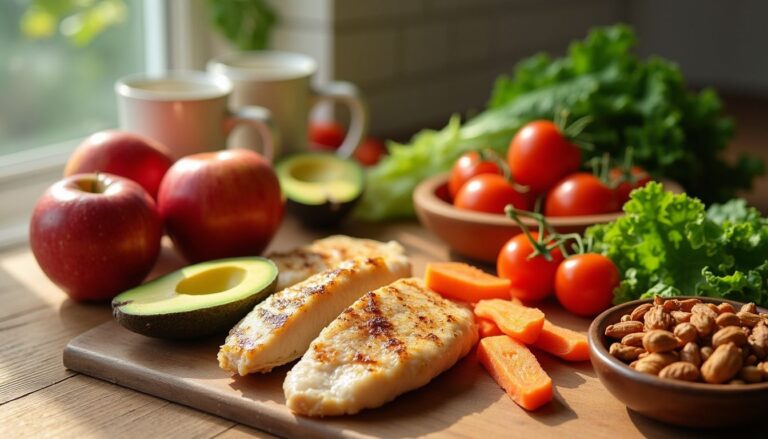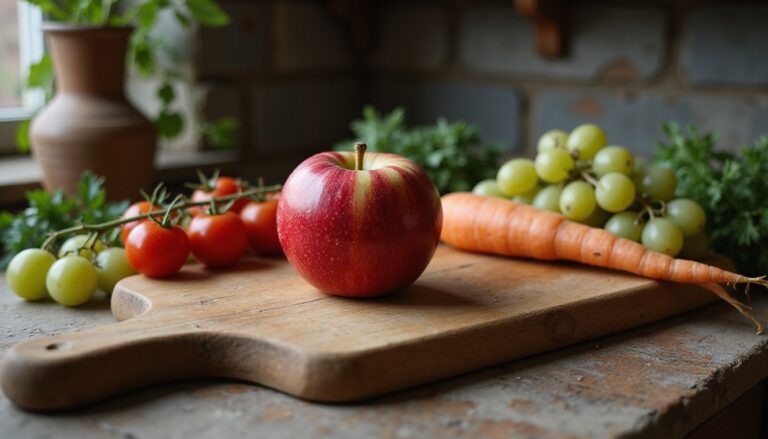Top Protein Foods For Weight Loss: High-Protein Diet Essentials
Our Nutrition Assistant AI Suite will transform your body. You will lose fat, get toned, and build muscle. Gain confidence and optimal health.
Losing weight and keeping it off can feel tough. High-protein foods help you feel full, protect muscle, and support steady fat loss. This guide highlights the best protein sources, from lean meat and seafood to plant-based picks, and explains how a high-protein diet supports healthy weight loss.
Start your journey to a stronger body today!
Key Takeaways
- Higher protein intake, about 1.0 to 1.2 grams per kilogram of body weight daily, helps preserve muscle and increases calories burned during digestion (Harvard T.H. Chan School of Public Health).
- Lean meats such as skinless chicken or turkey breast, lean beef cuts labeled loin or round, and seafood like salmon and tuna deliver 20 to 30 grams of protein per 100 grams with lower saturated fat.
- Dairy, including Greek yogurt, cottage cheese, eggs, and skim milk, promotes fullness and supplies nutrients such as calcium and vitamin D for bone and heart health.
- Plant-based protein from lentils, black beans, chickpeas, tofu, tempeh, and quinoa, a complete protein, makes it easier to meet daily goals without animal foods.
- Protein increases satiety through hormones like peptide YY, supports appetite control across four to five meals per day, maintains metabolism, and aids long-term fat loss (Journal of Nutrition, 2015).
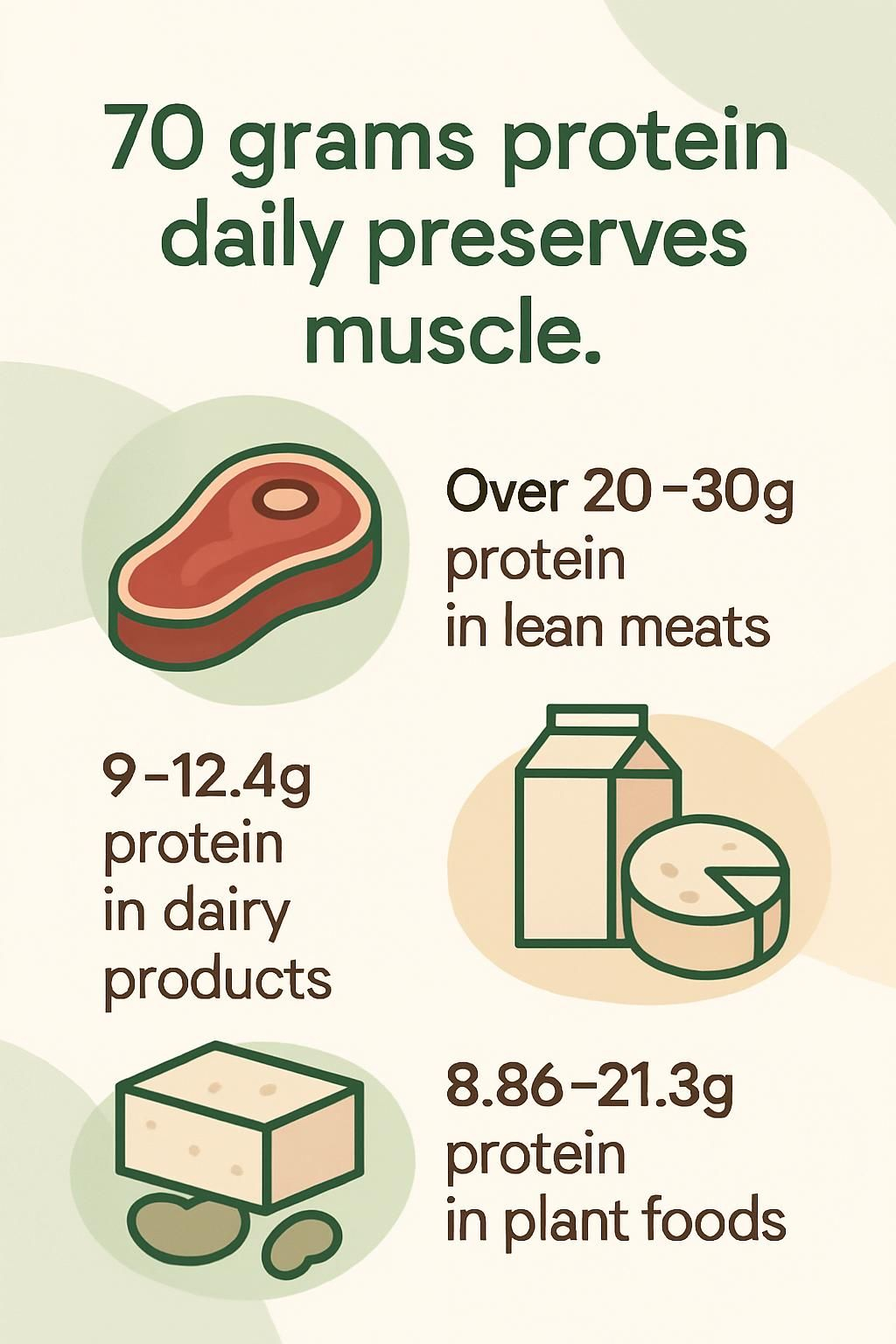
Why Protein is Essential for Weight Loss
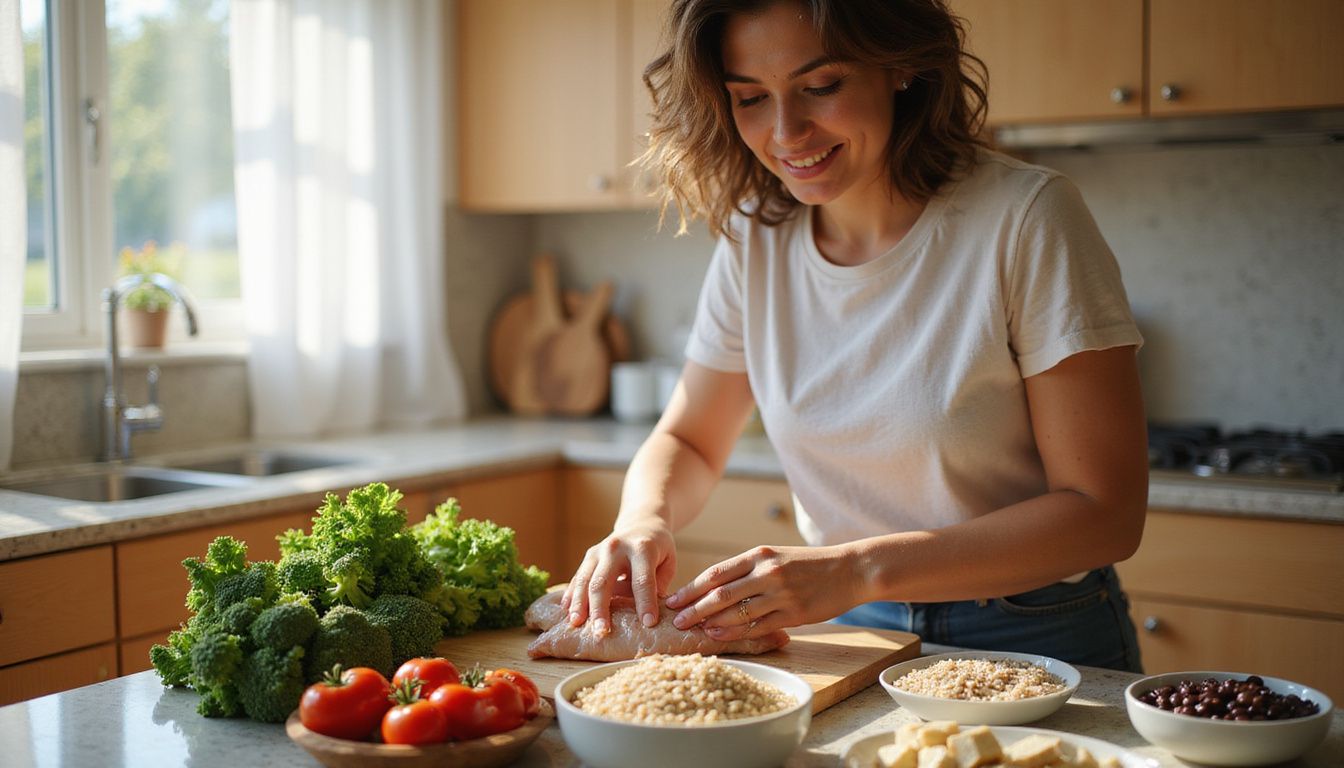
Protein helps you feel satisfied and protects lean muscle during calorie cuts. It also raises the energy you burn while digesting food, which supports a high-protein diet plan for weight loss.
How does protein promote satiety and reduce hunger?
Protein keeps you full longer than equal calories from carbs or fat. When you include foods like lean meat, Greek yogurt, eggs, or beans, your body releases peptide YY, a hormone that reduces hunger. This lowers cravings and cuts the urge to snack on calorie-dense foods.
Splitting your intake into four or five protein-rich meals or snacks helps manage appetite and total calories. Aim for a steady protein intake throughout the day, targeting roughly 1.0 to 1.2 grams per kilogram of body weight. This approach supports healthy eating while keeping hunger in check.
In what ways does protein boost metabolism and calorie burning?
Your body burns more energy to digest protein than it does for carbs or fat. This is called the thermic effect of food, or TEF. Protein raises TEF by roughly 15 to 30 percent, while carbs and fat raise it by about 5 to 10 percent. For example, from 100 calories of protein, up to 30 calories may be used in digestion.
Protein also preserves muscle. Muscle tissue burns more calories at rest than fat tissue. Keeping muscle during weight loss helps maintain your metabolic rate. Many experts suggest at least 1.0 to 1.2 grams of protein per kilogram of body weight daily if you are trying to lose fat without losing muscle.
Why is preserving muscle mass important during weight loss?
Muscle drives your resting metabolism. If you lose too much muscle while dieting, your daily calorie burn drops, and weight regain becomes more likely. Adequate protein protects lean mass and supports strength and energy.
Most adults do well with 1.0 to 1.2 grams of protein per kilogram during weight loss. Older adults may benefit from the higher end, since age-related muscle loss is common. Protecting muscle keeps you active, reduces fatigue, and improves long-term results.
Best High-Protein Foods for Weight Loss
Choosing the right protein sources makes a big difference. The foods below are rich in protein and fit easily into a healthy eating plan.
Which lean meats are best for weight loss?
Lean meats deliver a lot of protein with fewer calories from fat. Pick cuts that trim saturated fat while keeping protein high.
- Skinless chicken breast offers about 31 grams of protein per 100 grams with very little fat, a top pick for a high-protein diet for weight loss.
- Skinless turkey breast provides roughly 29 to 30 grams of protein per 100 grams and is very low in fat.
- Lean beef cuts labeled loin or round deliver about 26 grams of protein per 100 grams with lower saturated fat when trimmed.
- Pork tenderloin or center loin has about 22 to 24 grams of protein per 100 grams with modest fat if you trim visible fat.
- Bison provides about 22 to 24 grams of protein per 100 grams and is typically lower in total and saturated fat than many red meats.
- Avoid processed meats like bacon, sausage, and deli meats. These are high in sodium and nitrates and can raise heart and blood pressure risks.
Lean animal protein helps preserve muscle during calorie restriction and provides all essential amino acids. This supports strength while you lose fat.
Is chicken breast a good protein source for weight loss?
Yes. A 3-ounce serving of skinless chicken breast has about 26 grams of high-quality protein with few calories from fat. Per 100 grams, chicken breast averages close to 31 grams of protein.
Chicken breast is versatile. Add it to salads, stir-fries, or wraps. Pair it with fiber-rich vegetables for a filling, lower calorie meal that supports muscle while you cut calories.
How does turkey breast support weight loss?
Turkey breast is similar to chicken in protein and even leaner when skinless. Each 100 grams of cooked turkey breast provides about 30 grams of protein and very little fat.
Use sliced turkey in grain bowls, salads, or lettuce wraps. The high protein supports satiety, which reduces snacking and helps you stay within your calorie target.
What benefits does beef offer for a high-protein diet?
Beef supplies complete protein and key minerals such as iron and zinc. Per 100 grams, lean beef provides around 25 to 26 grams of protein.
Choose cuts marked loin or round and trim visible fat. This keeps saturated fat lower while you still get a lot of protein. Enjoy lean beef in stir-fries, chili, or tacos with plenty of vegetables.
How does bison compare as a lean protein option?
Bison provides about 25 grams of protein per 100 grams and is usually leaner than many beef cuts. It tastes rich and cooks like ground beef, which makes swapping easy.
Try bison in burgers, meatballs, or chili. The lower fat content helps you manage calories while maintaining protein intake for muscle support.
What seafood choices are high in protein for weight loss?
Seafood is an excellent source of protein and supports heart health. A typical 3-ounce fillet provides 17 to 20 grams of protein with few calories.
- Salmon gives about 19 grams of protein per 3 ounces and includes omega-3 fats that support heart and brain health.
- Tuna offers around 20 grams of protein per 3 ounces and has minimal fat, ideal for cutting calories.
- Halibut supplies roughly 21 grams of protein per 3 ounces and works well in salads and grain bowls.
- Shrimp provides about 18 to 20 grams of lean protein per 3 ounces and cooks quickly for fast meals or snacks.
- Regularly include grilled salmon, tuna, halibut, or shrimp to reach your daily protein goals while supporting heart health.
Seafood is simple to prepare and pairs well with vegetables and whole grains for balanced meals.
Why is salmon recommended for a protein-rich diet?
Salmon has about 22 grams of protein per 100 grams and contains omega-3 fatty acids. These fats support heart and brain health and may reduce inflammation.
Salmon helps you feel full and supports muscle maintenance. It fits well in a high-protein diet and brings extra nutrients like potassium and antioxidants.
How does tuna contribute to weight loss goals?
Tuna provides about 24 grams of protein per 100 grams and is very low in fat and calories. High protein slows stomach emptying, which helps reduce hunger between meals.
Use tuna in salads, wraps, or with whole grains and vegetables. It is an easy swap for higher calorie meats and supports steady energy through the day.
What makes halibut a good protein source?
Halibut delivers about 18 grams of protein per 100 grams with very little fat. It is a mild, lean fish that suits many recipes.
Grill or bake halibut and serve with vegetables and a whole grain. The protein supports fullness, and the lighter texture makes meals satisfying without feeling heavy.
Are shrimp effective for increasing protein intake?
Yes. A 3-ounce serving of cooked shrimp has about 20 grams of protein with fewer than 85 calories. That makes shrimp a fast, lean way to add protein.
Toss shrimp into salads, stir-fries, or pasta with vegetables. Shrimp also brings nutrients like iodine, vitamin B12, and iron.
What dairy products help with weight loss?
Low-fat dairy offers high-quality protein with fewer calories. It also provides calcium and vitamin D for bone and heart health.
- Low-fat cottage cheese has about 12.4 grams of protein per half cup. It promotes fullness and supports muscle repair.
- Greek yogurt is thick and protein dense. A 4-ounce serving of low-fat plain yogurt provides about 6 grams of protein.
- Skim or low-fat milk delivers 8 grams of protein per cup along with calcium and vitamin D.
- Provolone and mozzarella provide more protein per ounce, but use smaller portions to limit saturated fat.
- Blend cottage cheese into smoothies or add to fruit for a balanced snack rich in protein and fiber.
Dairy can be combined with fruit, nuts, or seeds to build satisfying snacks that support your protein goal.
Why is Greek yogurt a top choice for protein?
Greek yogurt provides about 10 grams of protein per 100 grams. The thicker texture increases fullness, which helps reduce hunger and snacking.
It also contains probiotics that support gut health. Use plain Greek yogurt in smoothies, on oatmeal, or as a creamy base for dips and dressings.
How does cottage cheese support a high-protein diet?
Cottage cheese is a reliable, budget-friendly source of protein. Per 100 grams, it provides roughly 11 grams of protein, and a half cup of low-fat cottage cheese provides about 12.4 grams.
Enjoy it with fruit, whole grain toast, or vegetables. Its protein supports satiety and muscle maintenance during weight loss.
Is low-fat or skim milk beneficial for weight loss?
Yes. Low-fat milk offers 8 grams of protein per cup with fewer calories than whole milk. Skim milk is even lower in fat while keeping the same protein.
Swap higher calorie drinks for low-fat milk in coffee, smoothies, or cereal. This helps meet your daily protein needs with less saturated fat.
Can eggs and egg whites aid in losing weight?
Eggs are a compact source of protein. One large egg has about 6 grams of protein and roughly 70 calories. Per 100 grams, eggs have about 12 grams of protein.
Egg whites contain most of the protein and very little fat or cholesterol. Make omelets with vegetables, or add boiled eggs to salads for fast, high-protein meals.
Plant-Based Protein Sources
Plant-based protein supports weight loss and heart health. Legumes, soy foods, whole grains, and seeds make it easier to reach your daily protein target without animal protein.
What legumes and beans are best for protein?
Legumes and beans give you protein and fiber, a powerful combination for fullness and blood sugar control.
- Lentils provide about 9 grams of protein per half cup cooked, plus folate and minerals.
- Kidney beans offer about 7.7 grams per half cup cooked.
- Black beans supply about 8.86 grams per 100 grams.
- Chickpeas contain about 21.3 grams per 100 grams dry, great for hearty vegan meals.
- Edamame gives about 11 grams per half cup shelled and is a complete protein.
- Soybeans and soy foods like tofu and tempeh are staples with high protein and low saturated fat.
- Lima beans deliver around 7 grams per serving plus iron and potassium.
Add beans to salads, soups, bowls, and tacos. The fiber promotes fullness and supports your calorie plan.
How do lentils help with protein intake?
Lentils stand out for affordability and convenience. Per 100 grams cooked, lentils provide about 9 grams of protein with iron and potassium.
Use them in soups, stews, and salads, or make a simple lentil curry. Pair lentils with a whole grain like quinoa for a filling, high-protein meal.
Are black beans effective for weight loss?
Yes. Black beans supply around 8.86 grams of protein per 100 grams and are rich in fiber. Protein and fiber slow digestion, which helps control appetite and reduce snacking.
Add black beans to bowls, burritos, and chilis. They increase total protein and support muscle preservation during weight loss.
Why include chickpeas in a high-protein diet?
Chickpeas provide about 21.3 grams of protein per 100 grams dry, plus fiber and minerals. They are a staple for vegetarian and vegan diets.
Use chickpeas in salads, stews, and hummus. Roasted chickpeas also make a crunchy, high-protein snack that carries well.
What protein does edamame provide?
Edamame is a complete protein, which means it has all nine essential amino acids your body cannot make. One cup cooked offers about 18 grams of protein.
Snack on edamame with a pinch of sea salt, or toss it into stir-fries and grain bowls. It rivals the protein in some lean meats and adds iron and magnesium.
How do soy-based products support weight loss?
Soy foods like tofu, soy curls, and tempeh offer high protein with little saturated fat. Three ounces of firm tofu provide about 9 grams of protein, while tempeh is even higher.
Replacing higher calorie meats with soy options can reduce total calories and improve satiety. These foods also support muscle retention during a calorie deficit.
What are the benefits of tofu as a protein source?
Tofu provides around 10 grams of protein per 100 grams, with iron and often calcium. It absorbs flavors well and fits many cuisines.
Swap higher fat meats for tofu in stir-fries, curries, or sheet-pan meals. The protein supports fullness and makes it easier to meet your daily protein goal.
How does tempeh fit into a plant-based protein plan?
Tempeh delivers about 20.3 grams of protein per 100 grams. As a fermented soy food, it also brings fiber and minerals.
Slice, marinate, and pan-sear tempeh for tacos, sandwiches, or bowls. The firm texture makes it a satisfying meat alternative that keeps you full.
Which grains and seeds are high in protein?
Some grains and seeds pack surprising protein for their size. Small additions to meals can raise your total protein fast.
- Oats provide about 13.15 grams of protein per 100 grams.
- Quinoa has roughly 4.4 grams per 100 grams cooked and is a complete protein.
- Hemp seeds deliver around 31.6 grams per 100 grams, easy to add to smoothies or salads.
- Pumpkin seeds offer about 29.84 grams per 100 grams and supply key minerals.
- Chia seeds contain about 16.5 grams per 100 grams and add fiber for fullness.
- Almonds add plant protein plus healthy fats that support heart health.
- Adding oats and pumpkin seeds to overnight bowls can improve morning satiety.
Rotate seeds and grains for variety. This supports a nutrient-dense, high-protein diet while keeping meals interesting.
Why is quinoa considered a complete protein?
Quinoa contains all nine essential amino acids, so it is a complete protein like animal protein. Per 100 grams cooked, it provides about 4.4 grams of protein.
Quinoa makes meal prep simple because you do not need to combine it with other foods to improve protein quality. Swap it for white rice in salads and bowls to boost protein and fiber.
| Amino Acid | Present? |
|---|---|
| Histidine | Yes |
| Isoleucine | Yes |
| Leucine | Yes |
| Lysine | Yes |
| Methionine | Yes |
| Phenylalanine | Yes |
| Threonine | Yes |
| Tryptophan | Yes |
| Valine | Yes |
Use quinoa as a base for bowls with vegetables, beans, nuts, or a spoon of peanut butter for extra flavor and nutrients.
How do chia seeds contribute to protein intake?
Chia seeds contain about 16.5 grams of protein per 100 grams, along with fiber that expands in liquid and increases fullness. Sprinkle them on yogurt, oatmeal, or blend into smoothies.
They are cholesterol free and supply minerals like calcium and magnesium that support muscle function. Soaked chia added to overnight oats keeps breakfast satisfying for hours.
What makes pumpkin seeds a good protein snack?
Pumpkin seeds provide about 29.84 grams of protein per 100 grams and are easy to carry. One ounce has roughly 8.5 grams of protein plus magnesium, zinc, and iron.
Top salads, yogurt, and grain bowls with a small handful. The crunch adds texture, and the protein helps reduce hunger between meals.
| Portion Size | Protein Content | Key Minerals Present |
|---|---|---|
| 100 g | ~29.84 g | Magnesium, Zinc, Iron |
| 1 oz | ~8.5 g | Magnesium, Zinc, Iron |
Which vegetables are high in protein?
Vegetables contribute useful protein and fiber, especially when combined with other protein sources. Mix and match to raise your meal’s total protein.
- Broccoli: about 2.82 grams per 100 grams, plus fiber and vitamins.
- Brussels sprouts: about 3.38 grams per 100 grams, rich in vitamin C and K.
- Asparagus: about 2.4 grams per 100 grams, with potassium and folate.
- Green peas: roughly 5 grams per 100 grams, easy to add to many dishes.
- Spinach: about 2.9 grams per cooked cup, blends into eggs or smoothies.
- Artichokes: around 3.3 grams per medium, high in fiber.
- Sweet corn: about 3.2 grams per cooked cup, tasty in soups and bowls.
Use these vegetables to bulk up meals without many calories. They improve fullness and nutrient intake during weight loss.
How does broccoli provide protein for weight loss?
Per 100 grams, raw broccoli offers about 2.82 grams of protein. It is low in calories and high in fiber, which helps you feel full.
Swap higher calorie sides for steamed broccoli. It pairs well with lean meat or tofu to create a balanced, high-protein plate.
Why include Brussels sprouts in a protein-rich diet?
Brussels sprouts provide about 3.38 grams of protein per 100 grams and plenty of fiber. Fiber slows digestion and supports appetite control.
Roast, steam, or sauté them as a side, or toss into salads. They add protein and nutrients without many calories or added fat.
What protein does asparagus offer?
Asparagus contains about 2.4 grams of protein per 100 grams and is naturally low in calories. It works well with eggs, chicken, and fish to boost the protein content of a meal.
Steam or roast and season lightly with olive oil and lemon. Asparagus adds volume and nutrients that help you stay satisfied.
Tips to Incorporate High-Protein Foods into Your Diet
Simple tweaks can raise your protein intake and support steady weight loss. Use the strategies below to build satisfying, high-protein meals and snacks.
How can you combine proteins with fiber-rich vegetables?
Pair protein with vegetables to increase fullness and improve nutrition. This mix supports appetite control and better portion sizes.
- Add walnuts to spinach salads, or almonds to oatmeal with berries for a filling breakfast.
- Serve grilled chicken breast with roasted Brussels sprouts and quinoa for complete protein and fiber-rich carbs.
- Place lean beef slices over sautéed broccoli for a hearty, lower calorie dinner.
- Stir chickpeas or edamame into veggie stir-fries for extra plant protein.
- Blend Greek yogurt into a dressing for chopped vegetables to add dairy protein.
- Swap white rice for quinoa to raise protein and fiber per serving.
Research shows higher protein intake increases satiety and supports long-term weight control (Journal of Nutrition, 2015). Small additions like pumpkin seeds on grain bowls also add iron and magnesium.
Why choose lean protein options to reduce calories?
Lean protein lowers calories from fat while meeting your protein needs. Aim for choices with less than 10 grams total fat and 4.5 grams or less saturated fat per serving.
Pick skinless poultry, seafood, lean beef cuts labeled loin or round, and plant-based choices like tofu and lentils. These options make it easier to keep calories lower without sacrificing protein or satisfaction.
When should you use protein supplements?
Protein shakes or powders can help when life gets busy or your appetite is low. Use them to close gaps if you struggle to reach your daily protein target through food alone.
Have a shake after workouts or on rushed mornings. Choose products that list protein first, keep added sugar low, and fit your calorie plan.
How to plan meals with balanced macronutrients?
Build each meal with protein, fiber-rich carbs, and healthy fats. This balance improves fullness and energy, which helps you eat less without feeling deprived.
Ideas: grilled salmon over quinoa with steamed broccoli and a drizzle of olive oil. Or cottage cheese with fruit, nuts, and a few whole grain crackers. Divide your intake into four or five smaller meals or snacks to steady hunger and energy.
Is a High-Protein Diet Safe?
A high-protein diet can be safe and effective for many adults. Check with your healthcare provider before major changes, especially if you have kidney disease, diabetes, high blood pressure, or take prescription medication.
What is the recommended daily protein intake?
Most adults need at least 0.8 grams of protein per kilogram of body weight each day. For weight loss and muscle retention, 1.0 to 1.2 grams per kilogram is a practical target.
Example: at 175 pounds, that equals about 80 to 95 grams per day. The National Academy of Medicine notes that protein can make up 10 to 35 percent of total daily calories. Tracking your intake for a week helps you learn which meals meet your goal.
What are the potential risks of excessive protein consumption?
Very high protein intake can strain the kidneys, especially with existing kidney problems. Diets high in animal protein may raise LDL cholesterol if saturated fat is high, which can increase heart disease risk.
Other issues can include constipation, headaches, bad breath, dehydration, and missing key nutrients if carbs and produce are too low. If you have kidney disease or poor kidney function, avoid very high-protein diets and seek medical guidance.
Conclusion
Choosing top protein foods makes weight loss more manageable. A high-protein diet helps you feel full, protect muscle mass, and burn more calories through digestion.
Lean meats, fish, eggs, Greek yogurt, and tofu are nutrient dense and easier to fit into a calorie budget. Plant-based protein like lentils, edamame, and quinoa adds fiber for better fullness and steady energy.
Aim for balanced meals with protein, vegetables, and whole grains. If you have health conditions, talk with a qualified professional before changing your protein intake. With a clear plan and consistent choices, high-protein foods can support a healthy weight and long-term results.
FAQs
1. What are the best protein-rich foods for weight loss?
Lean meats such as chicken breast, turkey, and fish provide high-quality protein with fewer calories. Eggs, Greek yogurt, cottage cheese, lentils, and tofu also offer significant protein content while supporting a calorie deficit.
2. How does a high-protein diet help with weight loss?
A high-protein diet increases satiety and helps control hunger hormones according to research published in The American Journal of Clinical Nutrition (2015). Protein preserves lean muscle during calorie restriction which supports metabolism.
3. Can plant-based proteins support effective weight loss?
Yes; beans, lentils, quinoa, tempeh, and soy products supply essential amino acids needed for muscle maintenance. Studies show that plant-based diets can be just as effective for fat reduction when total protein intake is adequate.
4. How much daily protein should someone eat on a weight-loss plan?
Experts recommend 0.6 to 0.8 grams of protein per pound of bodyweight each day based on clinical guidelines from the Academy of Nutrition and Dietetics (2020). For example: A person weighing 150 pounds would need about 90 to 120 grams daily.
Summary: Choosing lean animal or plant sources ensures optimal nutrition while reducing calories. Consistent intake supports appetite control and muscle retention throughout your weight-loss journey; these strategies have helped me maintain energy levels during my own dietary changes.

